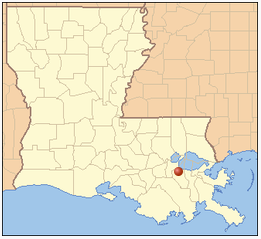| Home | Search | Emissions | Pollutants | About the Database |

Motiva Enterprises (1406), Norco
LDEQ Accident Report
| Accident # | 145719 |
| State Police # | 13-00075 |
| Accident Date | 2013-01-05 |
| Report Date | 2013-01-10 |
| Follow-up Date | 2013-03-07 |
| Follow-up: | Yes |
Pollutants Released
| Pollutant | Duration | Point Source | Greenhouse Gas | Criteria Pollutant | Ozone forming chemical | Amount of Release |
| Carbon Monoxide | 7d 23h 24m | RCCU Elevated Flare (EPN 8-84), 1-90(GO-1 Elevated Flare FE-602) | NO | YES | NO | 24,487.6 pounds |
| Nitrogen Dioxide | 7d 23h 24m | RCCU Elevated Flare (EPN 8-84), 1-90(GO-1 Elevated Flare FE-602) | NO | YES | YES | 4,500.4 pounds |
| Particulate Matter | 7d 23h 24m | RCCU Elevated Flare (EPN 8-84), 1-90(GO-1 Elevated Flare FE-602) | NO | YES | NO | 847.1 pounds |
| Sulfur Dioxide | 7d 23h 24m | RCCU Elevated Flare (EPN 8-84), 1-90(GO-1 Elevated Flare FE-602) | NO | YES | NO | 30,043.3 pounds |
| Volatile Organic Compounds (VOCs) | 7d 23h 24m | RCCU Elevated Flare (EPN 8-84), 1-90(GO-1 Elevated Flare FE-602) | NO | NO | YES | 11,466.2 pounds |
| Hexane | 7d 23h 24m | 1-90(GO-1 Elevated Flare, FE-602) | NO | NO | NO | 72.7 pounds |
Accident Classified As: Reportable Quantity
Cause of Problem: Piping or Tubing
On January 5, 2013, Motiva's Residual Catalytic Cracking Unit (RCCU) discovered a catalyst leak from a section of piping on the unit's West Secondary Cyclone Dip Leg. Operations responded immediately and worked to isolate this section of line. However, due to the location of the leak it was determined the line could not be isolated without shutting down the RCCU process unit. RCCU Operations then initiated a controlled unit shutdown following all operating and safety procedures. As part of the RCCU shutdown process, catalyst circulation within the West Secondary Cyclone Dip Leg was halted and the leak stopped. During this event, GO-1 flared RCCU Dry Gas at the GO-1 Elevated Flare (EPN 1-90) on January 6, 2013, January 9, 2013, and January 10, 2013. The GO-1 flaring resulted in reportable quantities exceeded during the release for Sulfure Dioxide and permit limit exceeded of Hexane on January 9, 2013 and January 10, 2013. Emission Calculations were performed using process data and appropriate AP-42 emission factors. Final update report 4/10/13 corrects cover letter of 3/7/13 report, which inaccurately stated that no reportable quantities were exceeded.
Discharge Preventable - No
This incident was not preventable by Motiva Enterprises LLC. The system is routinely inspected and no issues indicating imminent failure had been identified prior to the failure. This incident was not preventable by Shell Chemical. Shell Chemical could not accept the quality of the RCCU dry gas as unit feed as a result of the upset.
Notes/Remedial Actions
Immediate remedial actions: Operations worked to identify the source of the leak and made preparations for a repair. RCCU operations initiated a controlled unit shutdown to allow for maintenance repairs. As part of the RCCU shutdown process, catalyst circulation within the West Secondary Cyclone Dip Leg was halted and the leak stopped. Once this system was secure, Motiva contract maintenance personnel began welding repairs at the catalyst leak point. On January 8, 2013, the weld repairs on this system were completed and the system was returned to service. Motiva operations restarted the RCCU process unit following all operational and safety procedures on January 14, 2013. Additionally, there were no reportable quantities exceeded during the release. However, the maximum pound per hour limit for sulfur dioxide, carbon monoxide, nitrogen oxides, volatile organic compounds and particulate matter were exceeded. All materials routed to flare were combusted with an appropriate destruction efficiency of 99.5%, released from the RCCU Elevated Flare to the atmosphere, and dispersed naturally. To prevent recurrence of the incident, a field weld was made as a final repair to the leak. A release at Shell Chemicals resulted in flaring at the Shell facility as well as the Motiva facility. Motiva states that the flare release was not a reportable quantity, while Shell's release was.

Connect With Us: